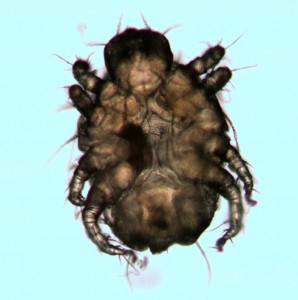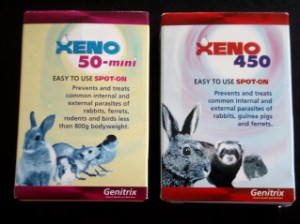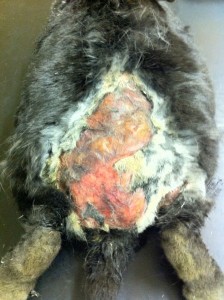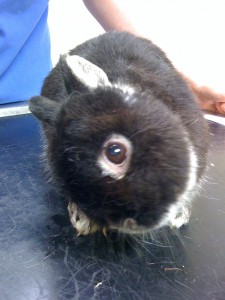Rabbit parasites
There are many different parasites from which your rabbit can suffer, but a few are very common, very treatable and easily recognised by the owner. Here we discuss those common few, the signs your rabbit may show and how your vet may treat them.
Cheyletiella (Walking Dandruff)
- Cheyletiella is a fur mite, it lives in your rabbits fur and can cause a severe dandruff.
- The signs of a Cheyletiella infestation can be very variable, from a small patch of scurfy skin, to the whole of the rabbits body being covered in white flakes and patches of hair loss.
- Some rabbits are very itchy with Cheyletiella and can cause areas of redness, scabs and infection by biting themselves, whereas others are fine.
- It is quite possible for two rabbits to live together and one be very badly affected and the other to be fine. There is a big individual variation in how much rabbits are affected by Cheyletiella.
- The mite is in the environment all the time, your rabbit may be affected because of a bad batch of hay or straw, or sometimes if they are ill for other reasons and their immune system is low.
- The Cheyletiella mite is quite large. If you remove some of the scale onto a dark surface, you may spot some bits moving. These are the mites, hence the name ‘Walking Dandruff’
- A Cheyletiella infestation can be diagnosed by the symptoms alone, or by examining some of the scale under a microscope and finding the mites.
- Cheyletiella can be treated with either three injections of an anti-parasitic medication, each a week apart, or by a spot-on, ‘Xeno 450’, which also needs three applications three weeks apart.
- It can also be treated with medicated shampoos.
- Your vet will be able to advise you on the best treatment for your rabbit.

This is a Cheyletiella mite under a microscope.

There are now spot-on treatments available to treat the mites, your vet may also suggest injections or washes
Fleas
- Rabbits can be affected by 2 different kinds of flea, the cat flea (Ctenocephalides felis), or the rabbit flea, (Spilopsylla cuniculi)
- Infection with the cat flea is by far the most common, and becoming more so now lots of rabbits are kept as house pets, often with cats or dogs as well.
- Rabbits may or may not be itchy when they are infected with fleas. The best way to diagnose a flea infestation is to check for flea dirt, like you would in a dog or cat. To learn how to do this click here.
- The rabbit flea is also know as the ‘stick tight’ flea. As they will attach themselves to the edges of the ears and stay there. They are not as common as the cat flea, rabbits will be infected with them generally only if they are in contact with wild rabbits.
- However, the rabbit flea is still important as it can carry myxomatosis. To learn more about myxomatosis, click here.
- Advantage flea treatment is licensed for rabbits and will both kill the adult flea and help prevent the larvae and eggs from developing in the environment.
- Xenex Ultra spot-on can also be used to control fleas in rabbits, it also kills ticks, lice and repels flies
- It is very important if a house rabbit is affected by fleas to treat the environment as well as this is where the eggs and larvae will live and develop. To learn more about this, click here.
- Only use flea treatment on rabbits that is specifically for them, using products designed for cats or dogs can be very harmful.
Flystrike
- This is a very serious condition that rabbits can develop, especially in the summer months. It is also discussed in common health problems of rabbits but we will cover it again here as it is so life threatening, common and yet so easily prevented.
- Rabbits produce 2 different kinds of faeces, a hard pellet which is the final product, and a much softer pellet which is designed to be eaten again. (caecotrophs)
- The rabbits diet should consist of large quantities of roughage, and in order to extract all the nutrition from it, they digest it twice.
- If the rabbits do not eat the softer pellets, for example, they may be too fat to reach them, be fed too much other food so they are too full, or they are not cleaned out often enough, they will collect around the bottom in a large mass call a ‘faecolith’.
- This is very attractive to flies, who lay their eggs here, which hatch into maggots. The maggots will eat through the faeces, and then start on the rabbit.
- The maggots can cause huge amounts of damage in a very short space of time, within 12 hours they can go from eggs to nearly fully grown. They will feed on the rabbit, causing the skin to die, and can even gain entry into the abdominal cavity.
- The treatment of flystrike involves removal of the maggots, treating the rabbit for shock, and giving pain relief and antibiotics.
- Rabbits can survive if the problem is caught early enough, but many die despite treatment, or have to be euthanased.
- There are 2 products which can be used to repel the flies. The first is a liquid you ‘paint’ onto the rear end of the rabbit, it repels flies for 12 weeks. The second is ‘Xenex 450’ it is a spot-on product that needs to be used every 2 weeks during the risky summer months to repel flies and prevent eggs from developing.

This rabbit was extremely lucky to have survived a fly strike attack but you can see how extensive the damage is that is done to the skin.
E. Cuniculi
- E. Cuniculi (or Encephalitozoon Cunciuli), is a single celled parasite that is very common in rabbits and can cause a variety of problems.
- It can infect the kidneys, cause urinary problems, eye problems, weight loss, weakness, wobbliness or head tilts, and even death.
- However, many infected rabbits have no symptoms at all, which means it can pass between rabbits without anyone knowing.
- Due to the wide nature of E.cuniculi infections, the symptoms can be very variable, they can include;
- Urinary incontinence or cystitis
- Increase in drinking and urinating – which is related to the kidney damage
- Weight loss
- Muscle weakness – so the rabbit finds it difficult to walk, or falls over a lot.
- Conjunctivitis, cataracts, sore eyes – this is due to the infection in the eyes and can be very painful.
- Head tilt – this is due to the infection being present in the brain, to learn more about head tilts, click here.
- The E.cuniculi spores are excreted in an infected rabbits urine, and they will easily infect any other rabbits that come into contact with them.
- E.cuniculi can be diagnosed by blood tests. However, so many rabbits are infected, that finding the parasite in the blood does not necessarily mean it is the cause of the symptoms the rabbit is showing.
- E. cuniculi is not easy to treat, it generally requires a long course of worming treatment, and some clinical signs, such as eye problems or head tilts may be permanent.
- There is now a product on the market called ‘Lapizole’, this is a 28 day course of wormer for rabbits. It treats and eliminates the infection. The manufacturers advise using on all rabbits, especially ones being introduced to a new home or other rabbits, because it eliminates E.cuniculi infections, it can prevent the passage of the parasite from rabbit to rabbit, even if they have no symptoms of disease.

This rabbit has a head tilt which is a typical symptom of an E. Cuniculi infection
Please note this is an advice only website, if you have any specific concerns or queries about your pet, you should contact your vet.